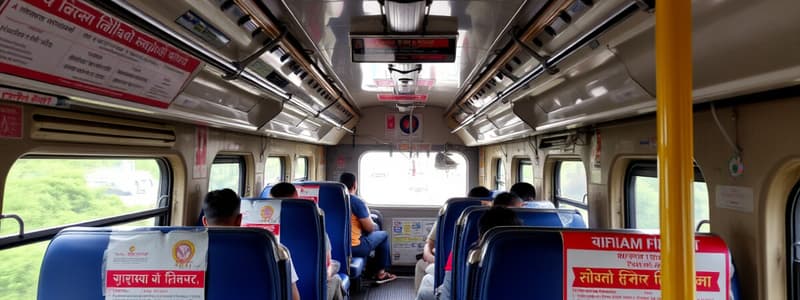Podcast
Questions and Answers
What does the term 'authority to proceed' refer to?
What does the term 'authority to proceed' refer to?
- Authorization for maintenance work
- Permission to stop the train
- Authority given to a Loco Pilot to enter a block section (correct)
- A warning signal for oncoming trains
How does an 'axle counter' function?
How does an 'axle counter' function?
- By monitoring the temperature of the wheels
- By recording the speed of the train
- By counting axles entering and exiting two points (correct)
- By measuring the weight of the train
What is indicated by a 'block back' message?
What is indicated by a 'block back' message?
- The block section is obstructed and needs attention (correct)
- A train has safely passed a block station
- The block section is clear for incoming trains
- A new train schedule has been released
What does 'Centralised Traffic Control' involve?
What does 'Centralised Traffic Control' involve?
Who is referred to as a 'Centralised Traffic Control Operator'?
Who is referred to as a 'Centralised Traffic Control Operator'?
What is defined as a 'block section'?
What is defined as a 'block section'?
What does the term 'direction of traffic' signify on a single line?
What does the term 'direction of traffic' signify on a single line?
What is meant by 'facing and trailing points'?
What is meant by 'facing and trailing points'?
Which role does the 'Commissioner of Railway Safety' play?
Which role does the 'Commissioner of Railway Safety' play?
What constitutes a 'competent railway servant'?
What constitutes a 'competent railway servant'?
What is a characteristic of Class 'A' block stations?
What is a characteristic of Class 'A' block stations?
What type of station is a non-block station classified as?
What type of station is a non-block station classified as?
Which statement is true regarding Class 'B' stations?
Which statement is true regarding Class 'B' stations?
Under what conditions may Line Clear be given at Class 'C' stations?
Under what conditions may Line Clear be given at Class 'C' stations?
What distinguishes a Special class block station?
What distinguishes a Special class block station?
Which of the following is true about block stations?
Which of the following is true about block stations?
What is an Intermediate Block Post classified as?
What is an Intermediate Block Post classified as?
How is the classification of a station indicated?
How is the classification of a station indicated?
What is the primary function of a block station?
What is the primary function of a block station?
Which category does not fall under block stations?
Which category does not fall under block stations?
What is meant by 'adequate distance' in the context of the Indian Railways rules?
What is meant by 'adequate distance' in the context of the Indian Railways rules?
Who is considered the 'authorised officer' as per the Indian Railways rules?
Who is considered the 'authorised officer' as per the Indian Railways rules?
What does 'approach lighting' refer to in railway operations?
What does 'approach lighting' refer to in railway operations?
What is the purpose of the 'approved special instructions'?
What is the purpose of the 'approved special instructions'?
When did the Indian Railways (Open Lines) General (Amendment) Rules 2015 come into force?
When did the Indian Railways (Open Lines) General (Amendment) Rules 2015 come into force?
What does the term 'Act' refer to in these rules?
What does the term 'Act' refer to in these rules?
Which of the following best describes 'approach lighting'?
Which of the following best describes 'approach lighting'?
What is NOT a responsibility of the authorised officer?
What is NOT a responsibility of the authorised officer?
Which of the following statements about the amendment rules is true?
Which of the following statements about the amendment rules is true?
Which of these definitions refers to safety measures in the railway context?
Which of these definitions refers to safety measures in the railway context?
What does the term ‘point and trap indicators’ refer to?
What does the term ‘point and trap indicators’ refer to?
Which of the following best defines ‘two-aspect signalling’?
Which of the following best defines ‘two-aspect signalling’?
What is indicated by a ‘last Stop signal’?
What is indicated by a ‘last Stop signal’?
What does the term ‘obstruction’ encompass in railway contexts?
What does the term ‘obstruction’ encompass in railway contexts?
Who is responsible for the overall traffic within station limits?
Who is responsible for the overall traffic within station limits?
What is the role of a ‘Gangmate’?
What is the role of a ‘Gangmate’?
Which type of train is designated solely for carrying passengers?
Which type of train is designated solely for carrying passengers?
What is the purpose of ‘interlocking’ in railway operations?
What is the purpose of ‘interlocking’ in railway operations?
What does ‘Line Clear’ indicate in railway terminology?
What does ‘Line Clear’ indicate in railway terminology?
Which of the following defines ‘level crossing’?
Which of the following defines ‘level crossing’?
What defines the 'block section' in railway operations?
What defines the 'block section' in railway operations?
Which term describes the communication sent to a block station indicating a section is obstructed?
Which term describes the communication sent to a block station indicating a section is obstructed?
What does the 'authority to proceed' entail for a Loco Pilot?
What does the 'authority to proceed' entail for a Loco Pilot?
What is the primary duty of a Centralised Traffic Control Operator?
What is the primary duty of a Centralised Traffic Control Operator?
Which device verifies the occupancy of a section of track by counting axles?
Which device verifies the occupancy of a section of track by counting axles?
In the context of railway direction, what does 'facing point' refer to?
In the context of railway direction, what does 'facing point' refer to?
What describes the functions of the Commissioner of Railway Safety?
What describes the functions of the Commissioner of Railway Safety?
What aspect does 'connections' refer to in railway terms?
What aspect does 'connections' refer to in railway terms?
What is the standard duration defined for a 'day' in railway operations?
What is the standard duration defined for a 'day' in railway operations?
What role does the 'Controller' serve in railway operations?
What role does the 'Controller' serve in railway operations?
What is the main purpose of the term 'adequate distance' as defined in the rules?
What is the main purpose of the term 'adequate distance' as defined in the rules?
Which statement is the most accurate regarding 'approach lighting'?
Which statement is the most accurate regarding 'approach lighting'?
In the context of the Indian Railways rules, who holds the authority to issue instructions as defined by the term 'authorised officer'?
In the context of the Indian Railways rules, who holds the authority to issue instructions as defined by the term 'authorised officer'?
What is the significance of 'approved special instructions' in railway operations?
What is the significance of 'approved special instructions' in railway operations?
What does the term 'Act' signify in the rules under discussion?
What does the term 'Act' signify in the rules under discussion?
Which of the following accurately describes the role of the Chief Operations Manager as mentioned in the rules?
Which of the following accurately describes the role of the Chief Operations Manager as mentioned in the rules?
Which of the following functions does 'adequate distance' NOT serve in railway safety regulations?
Which of the following functions does 'adequate distance' NOT serve in railway safety regulations?
The term 'approved special instructions' is associated with which aspect of railway management?
The term 'approved special instructions' is associated with which aspect of railway management?
Which aspect is NOT included in the definition of 'approach lighting'?
Which aspect is NOT included in the definition of 'approach lighting'?
What does the term 'fouling mark' refer to?
What does the term 'fouling mark' refer to?
What is the primary purpose of 'interlocking'?
What is the primary purpose of 'interlocking'?
Which of the following best describes the role of a 'Gateman'?
Which of the following best describes the role of a 'Gateman'?
What is indicated by the term 'Isolation' in railway terms?
What is indicated by the term 'Isolation' in railway terms?
Which type of train is specifically intended for carrying railway materials?
Which type of train is specifically intended for carrying railway materials?
In the context of railway signaling, what does 'multiple-aspect signaling' refer to?
In the context of railway signaling, what does 'multiple-aspect signaling' refer to?
What comprises an 'Intermediate Block Post'?
What comprises an 'Intermediate Block Post'?
Which of the following statements accurately describes 'running train'?
Which of the following statements accurately describes 'running train'?
What is indicated by a 'last Stop signal'?
What is indicated by a 'last Stop signal'?
What does the term 'station limits' define?
What does the term 'station limits' define?
What distinguishes Class 'B' stations from Class 'A' stations?
What distinguishes Class 'B' stations from Class 'A' stations?
Which of the following accurately describes a Special class block station?
Which of the following accurately describes a Special class block station?
What must be true for a Class 'C' station to grant Line Clear?
What must be true for a Class 'C' station to grant Line Clear?
Which statement is true regarding non-block stations?
Which statement is true regarding non-block stations?
How is a Class 'A' station differentiated from Class 'C' stations?
How is a Class 'A' station differentiated from Class 'C' stations?
In the context of the classification of stations, what is the role of a block hut?
In the context of the classification of stations, what is the role of a block hut?
What condition must be satisfied for a Loco Pilot to receive authority at a block station?
What condition must be satisfied for a Loco Pilot to receive authority at a block station?
What is required to classify a station as a Class 'D' station?
What is required to classify a station as a Class 'D' station?
Which statement regarding the classification of stations is correct?
Which statement regarding the classification of stations is correct?
Flashcards
Main Line
Main Line
The primary line on which trains travel.
Centralised Traffic Control
Centralised Traffic Control
A system used to control train movement remotely.
Adequate Distance
Adequate Distance
The distance necessary for safety, usually involving trains and movement.
Authorized Officer
Authorized Officer
Signup and view all the flashcards
Block Section
Block Section
Signup and view all the flashcards
Fixed Signal
Fixed Signal
Signup and view all the flashcards
Authority to Proceed
Authority to Proceed
Signup and view all the flashcards
Competent Railway Servant
Competent Railway Servant
Signup and view all the flashcards
Direction of Traffic
Direction of Traffic
Signup and view all the flashcards
Loco Pilot
Loco Pilot
Signup and view all the flashcards
Running Train
Running Train
Signup and view all the flashcards
Passenger Train
Passenger Train
Signup and view all the flashcards
Axle Counter
Axle Counter
Signup and view all the flashcards
Two-Aspect Signalling
Two-Aspect Signalling
Signup and view all the flashcards
Line Clear
Line Clear
Signup and view all the flashcards
Level Crossing
Level Crossing
Signup and view all the flashcards
Class A Block Station
Class A Block Station
Signup and view all the flashcards
Class B Block Station
Class B Block Station
Signup and view all the flashcards
Class C Block Station
Class C Block Station
Signup and view all the flashcards
Non-block Stations (Class D)
Non-block Stations (Class D)
Signup and view all the flashcards
Block Stations
Block Stations
Signup and view all the flashcards
Station Working Rules (SWR)
Station Working Rules (SWR)
Signup and view all the flashcards
Working Time Table
Working Time Table
Signup and view all the flashcards
Special Class Block Station
Special Class Block Station
Signup and view all the flashcards
Approach Lighting
Approach Lighting
Signup and view all the flashcards
Amendment Rules 2015
Amendment Rules 2015
Signup and view all the flashcards
Act
Act
Signup and view all the flashcards
Approved Special Instructions
Approved Special Instructions
Signup and view all the flashcards
Commissioner of Railway Safety
Commissioner of Railway Safety
Signup and view all the flashcards
Study Notes
Chapter I: Preliminary
- Rules titled Indian Railways (Open Lines) General (Amendment) Rules 2015 are effective upon publication in the Official Gazette.
Definitions
- Act - Refers to the Railways Act, 1989 (24 of 1989).
- Adequate Distance - Defined as the distance sufficient for safety.
- Approach Lighting - Automatic control of signal lighting based on train approach.
- Approved Special Instructions - Instructions approved by the Commissioner of Railway Safety.
- Authorized Officer - Person empowered by the Railway Administration to issue instructions; includes the Chief Operations Manager.
- Authority to Proceed - Permission given to the Loco Pilot to enter a block section.
- Axle Counter - Electrical device that counts axles to determine track occupancy.
- Block Section - The area between two block stations, with entry restricted until Line Clear is received.
- Centralised Traffic Control - A system governing train movements remotely.
- Commissioner of Railway Safety - Official responsible for functions outlined under the Act, including the Chief Commissioner.
Operational Terms
- Competent Railway Servant - Qualified railway personnel authorized for specific duties.
- Direction of Traffic - Signalling direction for trains on single or double lines.
- Fixed Signal - Signals indicating train movement conditions, applicable day and night.
- Level Crossing - Intersection where road and railway tracks meet.
- Line Clear - Permission for a train to leave one block station to approach another.
Train and Signalling
- Loco Pilot - The operator in charge of driving the train.
- Main Line - Primary line used for train passage.
- Passenger Train - Specifically for carrying passengers; troop trains included.
- Running Train - A train that has departed with the authority to proceed.
- Two-Aspect Signalling - Signalling displaying either of two distinct aspects.
Station Classification
- Stations classified into block stations (need authority for train entry) and non-block stations (stopping places between block stations).
- Block Station Classes:
- Class A - Requires clear line for 400 meters beyond the Home signal before giving Line Clear.
- Class B - Line Clear may be given before clearing the line within the station section.
- Class C - Line Clear only after the previous train has passed 400 meters beyond the Home signal.
- Non-block Stations (Class D) - Stopping places that do not form boundaries of any block section.
Special Considerations
- Classification of the station must be noted in the station's SWR (Station Working Rules) and Working Time Table.
- Block stations unable to meet Class A, B, or C conditions are classified as 'Special class'.
Chapter I: Preliminary
- Rules titled Indian Railways (Open Lines) General (Amendment) Rules 2015 are effective upon publication in the Official Gazette.
Definitions
- Act - Refers to the Railways Act, 1989 (24 of 1989).
- Adequate Distance - Defined as the distance sufficient for safety.
- Approach Lighting - Automatic control of signal lighting based on train approach.
- Approved Special Instructions - Instructions approved by the Commissioner of Railway Safety.
- Authorized Officer - Person empowered by the Railway Administration to issue instructions; includes the Chief Operations Manager.
- Authority to Proceed - Permission given to the Loco Pilot to enter a block section.
- Axle Counter - Electrical device that counts axles to determine track occupancy.
- Block Section - The area between two block stations, with entry restricted until Line Clear is received.
- Centralised Traffic Control - A system governing train movements remotely.
- Commissioner of Railway Safety - Official responsible for functions outlined under the Act, including the Chief Commissioner.
Operational Terms
- Competent Railway Servant - Qualified railway personnel authorized for specific duties.
- Direction of Traffic - Signalling direction for trains on single or double lines.
- Fixed Signal - Signals indicating train movement conditions, applicable day and night.
- Level Crossing - Intersection where road and railway tracks meet.
- Line Clear - Permission for a train to leave one block station to approach another.
Train and Signalling
- Loco Pilot - The operator in charge of driving the train.
- Main Line - Primary line used for train passage.
- Passenger Train - Specifically for carrying passengers; troop trains included.
- Running Train - A train that has departed with the authority to proceed.
- Two-Aspect Signalling - Signalling displaying either of two distinct aspects.
Station Classification
- Stations classified into block stations (need authority for train entry) and non-block stations (stopping places between block stations).
- Block Station Classes:
- Class A - Requires clear line for 400 meters beyond the Home signal before giving Line Clear.
- Class B - Line Clear may be given before clearing the line within the station section.
- Class C - Line Clear only after the previous train has passed 400 meters beyond the Home signal.
- Non-block Stations (Class D) - Stopping places that do not form boundaries of any block section.
Special Considerations
- Classification of the station must be noted in the station's SWR (Station Working Rules) and Working Time Table.
- Block stations unable to meet Class A, B, or C conditions are classified as 'Special class'.
Studying That Suits You
Use AI to generate personalized quizzes and flashcards to suit your learning preferences.




